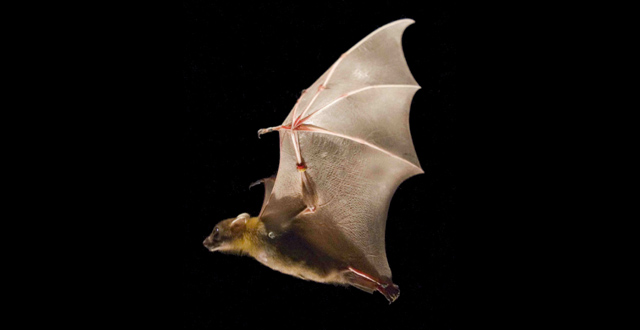A team of researchers has found that bats take advantage of their flexibility by folding in their wings on the upstroke to save inertial energy.

Efficiencies of flapping flight: by folding their wings in toward their bodies on the upstroke, bats use 35 percent less energy and reduce aerodynamic drag, compensating for heavier, more muscular wings (Attila Breuer / Sharon Swartz / Brown University)
The study, published on April 11 in the Proceedings of the Royal Society B, shows that by flexing their wings inward to their bodies on the upstroke, bats use only 65 percent of the inertial energy they would expend if they kept their wings fully outstretched. Unlike insects, bats have heavy, muscular wings with hand-like bendable joints.
“Wing mass is important and it’s normally not considered in flight,” said Dr. Attila Bergou of Brown University, a co-author of the study. “Typically you analyze lift, drag, and you don’t talk about the energy of moving the wings.”
The findings not only help explain why bats and some birds tuck in their wings on the upstroke, but could also help inform human designers of small flapping vehicles.
“If you have a vehicle that has heavy wings, it would become energetically beneficial to fold the wings on the upstroke,” said Prof. Sharon Swartz of Brown University.
The team analyzed 1,000 frames-per-second videos of 27 bats performing five trials each aloft in a flight corridor or wind tunnel. They tracked markers on the bats, who hailed from six species, and measured how frequently the wings flapped, how far up and down they flapped, and the distribution of mass within them as they moved. They measured the mass by cutting the wing of a bat that had died into 32 pieces and weighing them.
They fed the data in to a calculus-rich model that allowed them to determine what the inertial energy costs of flapping were and what they would have been if the wings were kept outstretched.
Dr. Bergou said he was surprised that the energy savings was so great, especially because the calculations also showed that the bats have to spend a lot of energy – 44 percent of the total inertial cost of flapping – to fold their wings inward and then back outward ahead of the downstroke.
“Retracting your wings has an inertial cost,” Dr. Bergou explained. “It is significant but it is outweighed by the savings on the up and down stroke.”
The conventional wisdom has always been that bats drew their wings in on the upstroke to reduce drag in the air, and although the team did not measure that, they acknowledge that aerodynamics plays the bigger role in the overall energy budget of flying. But the newly measured inertial savings of drawing in the wings on the upstroke seems too significant to be an accident.
“It really is an open question whether natural selection is so intense on the design and movement patterns of bats that it reaches details of how bats fold their wings,” Prof. Swartz said. “This certainly suggests that this is not a random movement pattern and that it is likely that there is an energetic benefit to animals doing this.”







